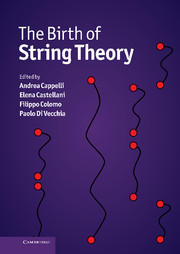Book contents
- Frontmatter
- Contents
- List of contributors
- Photographs of contributors
- Preface
- Abbreviations and acronyms
- Part I Overview
- EARLY STRING THEORY
- Part II The prehistory: the analytic S-matrix
- Part III The Dual Resonance Model
- 10 Introduction to Part III
- 11 From the S-matrix to string theory
- 12 Reminiscence on the birth of string theory
- 13 Personal recollections
- 15 Early string theory at Fermilab and Rutgers
- 15 Dual amplitudes in higher dimensions: a personal view
- 16 Personal recollections on dual models
- 17 Remembering the ‘supergroup’ collaboration
- 18 The ‘3-Reggeon vertex’
- Part IV The string
- TOWARDS MODERN STRING THEORY
- Part V Beyond the bosonic string
- Part VI The superstring
- Part VII Preparing the string renaissance
- Appendix A Theoretical tools of the Sixties
- Appendix B The Veneziano amplitude
- Appendix C From the string action to the Dual Resonance Model
- Appendix D World-sheet and target-space supersymmetry
- Appendix E The field theory limit
- Index
15 - Dual amplitudes in higher dimensions: a personal view
from Part III - The Dual Resonance Model
Published online by Cambridge University Press: 05 May 2012
- Frontmatter
- Contents
- List of contributors
- Photographs of contributors
- Preface
- Abbreviations and acronyms
- Part I Overview
- EARLY STRING THEORY
- Part II The prehistory: the analytic S-matrix
- Part III The Dual Resonance Model
- 10 Introduction to Part III
- 11 From the S-matrix to string theory
- 12 Reminiscence on the birth of string theory
- 13 Personal recollections
- 15 Early string theory at Fermilab and Rutgers
- 15 Dual amplitudes in higher dimensions: a personal view
- 16 Personal recollections on dual models
- 17 Remembering the ‘supergroup’ collaboration
- 18 The ‘3-Reggeon vertex’
- Part IV The string
- TOWARDS MODERN STRING THEORY
- Part V Beyond the bosonic string
- Part VI The superstring
- Part VII Preparing the string renaissance
- Appendix A Theoretical tools of the Sixties
- Appendix B The Veneziano amplitude
- Appendix C From the string action to the Dual Resonance Model
- Appendix D World-sheet and target-space supersymmetry
- Appendix E The field theory limit
- Index
Summary
This is a very personal view of the origin of string theory, and it also makes an interesting prediction.
When I first encountered the Veneziano model in 1968, I was at CERN working on the phenomenology of strong interactions. I saw an application to pion–pion scattering (Lovelace [Lov68] and Shapiro [Sha69]), which occurred independently to Shapiro and Yellin [SY70] at Berkeley. It attracted considerable attention, but now seems misguided. Later I combined dual amplitudes with Gribov's Reggeon calculus [Lov71b]. This application has been revived recently by people exploiting AdS/CFT duality, and should eventually succeed.
All through 1969 people were adding legs to the Veneziano amplitude, or chopping it in half. I will leave this story to other contributors. Amati and coworkers gave a series of seminars at CERN on their SL(2,ℝ) group theoretic formulation which I thought very elegant [AALO71]. This inspired me to drop phenomenology and join them. In modern language, the N-Reggeon vertex [Lov70a] is the open string disc amplitude with arbitrary excited states on all external lines. Several people had written down a complicated formula. I noticed it could be factorized by a single set of oscillators at the centre of the disc, and realized that an easy construction of the complete perturbation expansion to all orders in string loops would follow. Alessandrini and Amati [Ale71, AA71], and I [Lov70b] worked this out.
I am eulexic – my favourite way of developing an idea is to cover a table with piles of possibly relevant books and papers, and rapidly turn pages till I catch a scent like the one in my mind.
- Type
- Chapter
- Information
- The Birth of String Theory , pp. 198 - 201Publisher: Cambridge University PressPrint publication year: 2012
- 2
- Cited by

